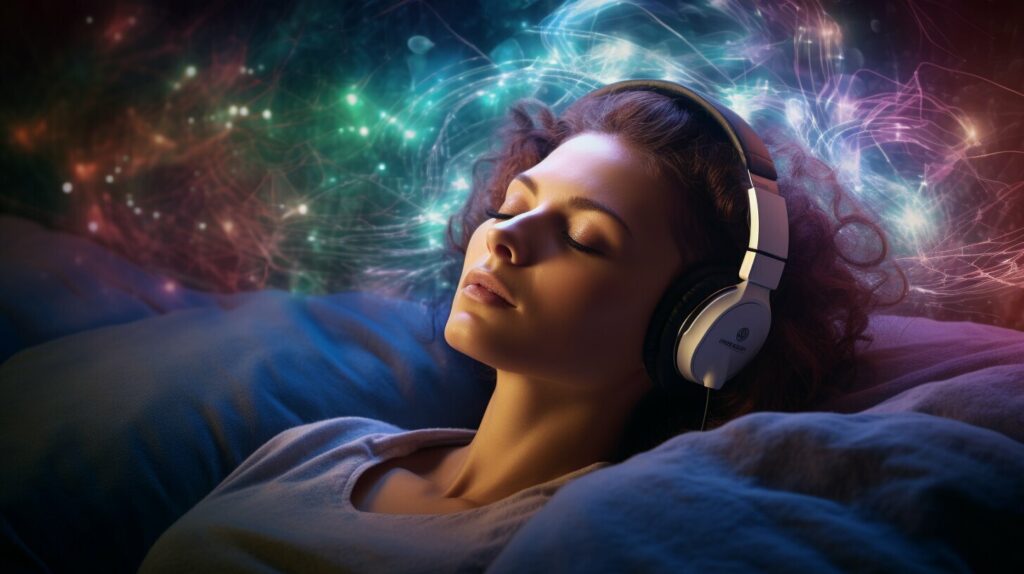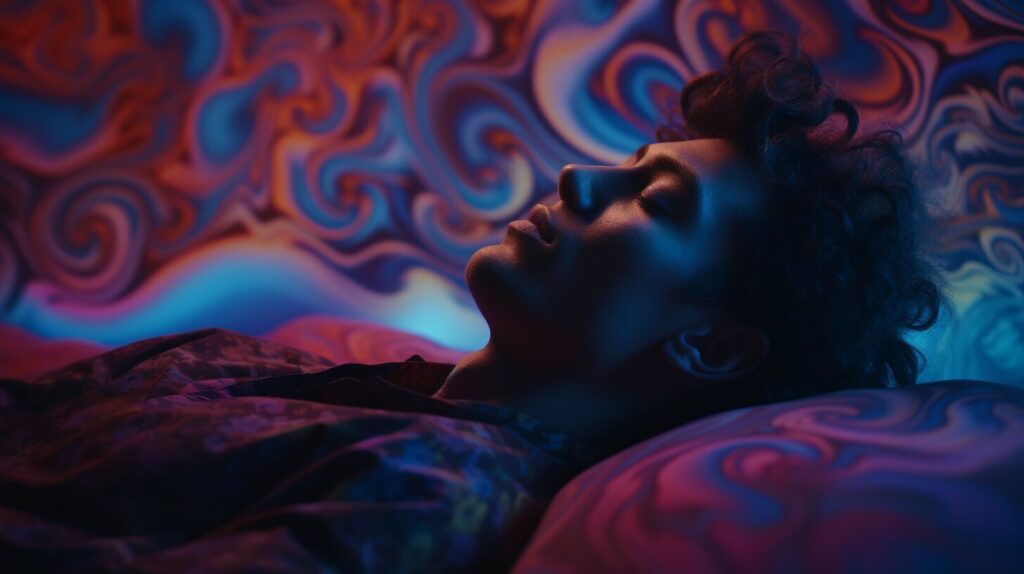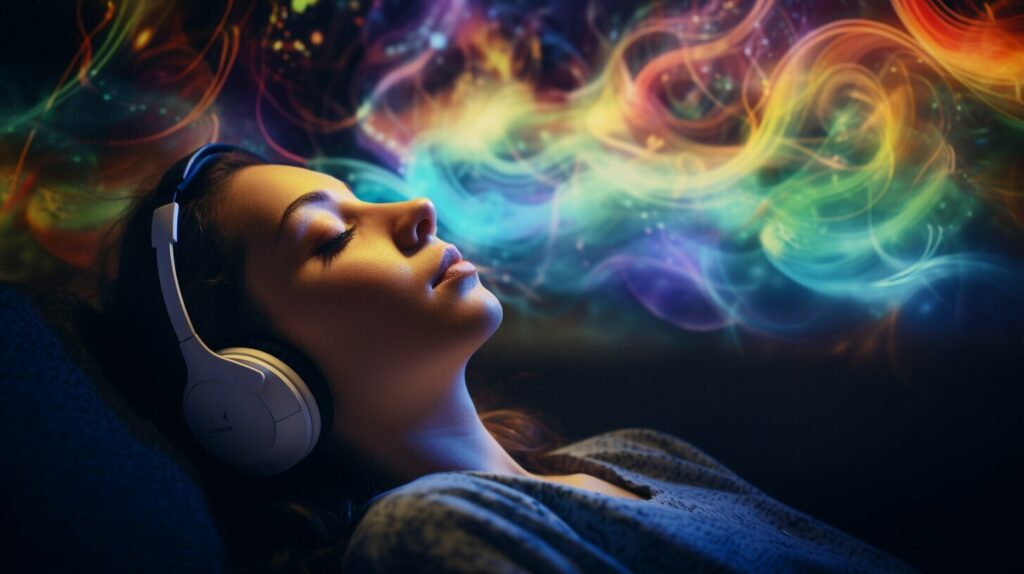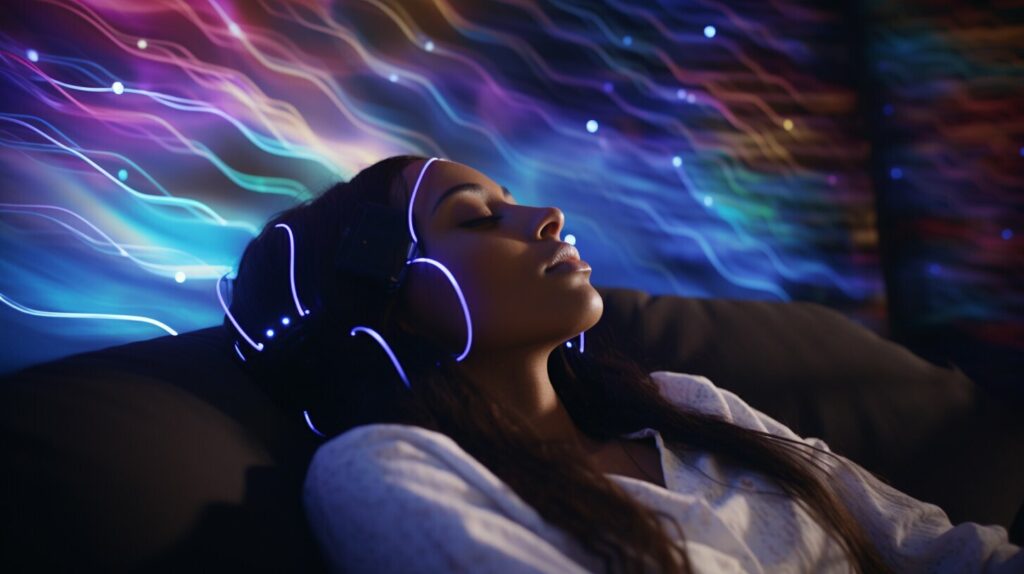Have you ever wished to control your dreams or experience a world beyond reality while sleeping? Lucid dreaming can make that a reality, allowing you to take control of your dreams and explore your subconscious mind.
Recently, there has been a growing trend of using soundscapes, music, binaural beats, dream soundtracks, self-hypnosis audio, and guided meditation audio to enhance lucid dreaming experiences. But the question remains, do lucid dream sounds work?
Join me as we explore the science behind lucid dreaming and sound and how they work together. We will also look at the different types of lucid dream sounds available, their potential benefits, and practical tips for enhancing lucid dreaming with sound.
Key Takeaways:
- Lucid dreaming allows individuals to control and explore their dreams.
- Lucid dream sounds, such as binaural beats and guided meditation, are becoming increasingly popular in enhancing lucid dreaming experiences.
- In this article, we will explore the science behind lucid dream sounds, the different types available, and practical tips for incorporating sound into lucid dreaming practices.
Understanding Lucid Dreaming and Sound
Before delving into the potential benefits of using sound to enhance lucid dreaming, it’s important to first understand what lucid dreaming is and how it differs from regular dreaming. In a lucid dream, the dreamer becomes aware that they are dreaming and can actively participate in shaping and controlling the dream’s content.
The concept of using sound to influence the dream state is based on the idea that certain frequencies and patterns can stimulate brainwave activity associated with lucid dreaming. Binaural beats, for example, are often used to create a difference in frequency between the two ears, which can potentially promote the brainwave patterns associated with lucid dreaming.
While the science behind lucid dreaming and sound is still being explored, many individuals have reported success in inducing lucid dreams through the use of soundscapes, music, and self-hypnosis or guided meditation audio. These types of audio are often used to create a relaxing and immersive sleep environment, promote deep sleep, and provide cues or suggestions for lucidity within dreams.

Understanding Lucid Dreaming and Sound
Lucid dreaming is a state of heightened awareness within a dream, where the dreamer is aware that they are dreaming and can manipulate the dream’s content. The use of sound to promote lucid dreaming is based on the idea that certain frequencies and patterns can stimulate brainwave activity associated with lucidity.
| Lucid Dreaming | Sound |
|---|---|
| Heightened awareness within a dream | Potential to stimulate brainwave activity associated with lucidity |
| Ability to shape and control dream content | Creates a relaxing and immersive sleep environment |
| Potential for deeper sleep and improved dream recall | Provides cues or suggestions for lucidity within dreams |
The Science Behind Lucid Dream Sounds
Many studies have been conducted to explore the effectiveness of lucid dream sounds, with mixed results. While some researchers have found that soundscapes, music, binaural beats, and other audio techniques can enhance dream experiences and promote lucidity, others have found little to no significant effect.
One study published in the journal Psychology of Consciousness: Theory, Research, and Practice found that listening to binaural beats in the theta range, which is associated with deep relaxation and meditation, increased the frequency of lucid dreams. However, another study published in the Journal of Sleep Research found no significant difference in lucid dream frequency or quality between participants who listened to isochronic tones, a type of audio stimulation, and those who did not.
Despite the mixed findings, some researchers suggest that individual differences in susceptibility to suggestion, as well as variations in sleep quality and other factors, may impact the effectiveness of lucid dream sounds. Personal experimentation and exploration may be the best means of determining whether audio techniques work for an individual.

Exploring Different Types of Lucid Dream Sounds
Lucid dream sounds come in many different forms, each with their own unique benefits. Here are some of the most popular types:
| Type of Sound | Description | Potential Benefits |
|---|---|---|
| Lucid Dream Soundscapes | Soundscapes are specifically designed to create an ambient dream-like atmosphere, featuring sounds such as flowing water, soft bird song, and gentle windchimes. | Can help promote relaxation, improve dream control, and increase dream vividness. |
| Lucid Dreaming Music | Music composed with the intention of inducing lucid dreaming often features hypnotic beats, repetitive rhythms, and dreamy melodies. | May help stimulate the brainwave patterns associated with lucid dreaming, enhance sensory and emotional experiences within dreams, and improve dream recall. |
| Dream Soundtracks | Dream soundtracks typically feature spoken word guidance, encouraging dreamers to visualize specific scenarios or engage in reality checks, designed to influence the contents of the dream. | Can provide structure and direction for dream experiences, promote lucid awareness, and increase dream control. |
When selecting lucid dream sounds to use, consider your personal preferences and the goals you have for your dream experiences. Experimenting with different types of sounds and techniques can help you find what works best for you.
 Lucid dream soundscapes can help create a dreamy atmosphere.
Lucid dream soundscapes can help create a dreamy atmosphere.
Benefits of Using Dream Sounds for Lucid Dreams
From personal experience and scientific research, using dream sounds can offer a range of benefits to enhance lucid dreaming experiences and improve overall sleep quality. Here are some potential benefits:
- Amplifying the sensory experience within dreams: Dream soundscapes and music can intensify the visual and auditory sensations in dreams, making them more vivid and memorable.
- Increasing dream recall: By providing a cue or trigger, dream soundtracks can help you remember more of your dreams upon waking up.
- Providing cues for reality checks: By incorporating specific sound cues into your dreams, you can increase the likelihood of realizing you are dreaming and performing reality checks.
- Improving dream control: Dream soundscapes and self-hypnosis audios can help you maintain focus and control over your dream experience, allowing you to explore and experiment with different scenarios.
- Promoting relaxation: Calming soundscapes and guided meditations can help you fall asleep faster and wake up feeling more refreshed.
- Enhancing overall sleep quality: By creating a peaceful and relaxing sleep environment, dream sounds can improve the quality and duration of your sleep, leading to better overall health and well-being.
By incorporating dream sounds into your lucid dreaming practice, you can potentially unlock a whole new level of dream exploration and self-discovery. However, it’s important to remember that individual results may vary and further research is needed to fully understand the benefits and limitations of this technique.

Lucid Dreaming Self-Hypnosis Audio
One popular type of lucid dream audio is self-hypnosis. In self-hypnosis audio programs, a voice guides the listener through a series of relaxation and visualization techniques to induce a lucid dream state. These techniques often include suggestions to become aware of dream signs, perform reality checks, and take control of the dream environment.
Self-hypnosis audio programs operate on the premise that the unconscious mind can be influenced through suggestion, and that by repeatedly exposing oneself to these suggestive messages, one can increase the likelihood of experiencing a lucid dream. Some self-hypnosis audio programs also incorporate binaural beats or other soundscapes to enhance the effectiveness of the program.
The effectiveness of self-hypnosis audio programs for lucid dreaming has been supported by anecdotal evidence from individuals who have used them with success. However, as with other types of lucid dream sound, the research on self-hypnosis audio remains limited, and the extent to which it can truly influence one’s dream state is still up for debate.

“Using self-hypnosis audio has been a game changer for me in my lucid dreaming practices. I’ve noticed that I’m able to become lucid more frequently and with greater ease since incorporating these programs.”
- Tip: When trying out self-hypnosis audio, make sure you are in a quiet and comfortable sleep environment to minimize distractions. It may also be helpful to listen to the audio as you are falling asleep or during a nap.
- Tip: Look for self-hypnosis audio programs from reputable sources that specialize in lucid dreaming induction. Programs that have received positive reviews from other users may also be worth considering.
Lucid Dreaming Guided Meditation Audio
Guided meditation audio is another popular tool used to facilitate lucid dreaming. Unlike binaural beats or soundscapes, guided meditation audios incorporate verbal instructions, suggestions, and imagery to guide the listener into a relaxed, receptive state that is conducive to lucid dreaming.
Guided meditation audios for lucid dreaming typically include prompts to focus on specific sensations, visualize dream scenarios, and perform reality checks. Some may also incorporate affirmations to build confidence in the ability to lucid dream.
One of the benefits of using guided meditation audio for lucid dreaming is the potential to improve dream recall. By training the mind to focus on and remember specific details during meditation, individuals may become more adept at recalling and recording their dream experiences.
Research on the efficacy of guided meditation audios for lucid dreaming is limited, but anecdotal evidence suggests that they can be effective for some individuals. Personal experiences reported by users indicate that guided meditation audios can help promote relaxation, increase dream vividness, and enhance the ability to control dream scenarios.

While guided meditation audio can be a useful tool for inducing lucid dreaming, it may not be effective for everyone. As with other lucid dream audios, personal experimentation and practice are key to determining its effectiveness for each individual.
Tips for Enhancing Lucid Dreaming with Sound
When using sound to promote lucid dreaming, there are a few key strategies that can help maximize its effectiveness. Here are some tips to enhance your lucid dreaming practice:
- Create a conducive sleep environment: Ensure that your sleeping environment is quiet, comfortable, and free from distractions. Consider using a sleep mask and earplugs to block out external stimuli.
- Select appropriate audio tracks: Choose audio tracks that are specifically designed to induce lucid dreaming or create a dream-like atmosphere. Experiment with different types of sounds, such as binaural beats, dream soundscapes, or guided meditations, to find what works best for you.
- Set intentions before sleep: Before going to bed, set a clear intention to have a lucid dream. Visualize yourself becoming aware in your dreams and take a few deep breaths to relax your mind and body.
- Maintain consistent practice: Regularly incorporate lucid dream sound techniques into your sleep routine. Practice makes perfect, and the more you use these techniques, the more likely you are to experience lucid dreams.
- Use sound as a cue for reality checks: Set reminders to perform reality checks throughout the day, and associate them with a specific sound from your lucid dream audio. This can help increase your frequency of reality checks and improve your overall awareness.
- Incorporate sound into a pre-sleep routine: Create a relaxing pre-sleep routine that incorporates your chosen lucid dream sounds. This can help signal to your brain that it’s time for sleep and increase your chances of having a lucid dream.
By following these tips, you can effectively use sound to enhance your lucid dreaming experiences. Remember, the key is to find what works best for you and maintain consistent practice. With time and dedication, you can unlock the incredible world of lucid dreaming.

Other Factors Affecting Lucid Dreaming
While lucid dream sounds can be a helpful tool for enhancing dream experiences, it’s important to keep in mind that other factors can also play a role in achieving lucidity. For example, maintaining good sleep hygiene by establishing a consistent sleep schedule and creating a sleep-conducive environment can improve the quality and frequency of lucid dreams.
Stress levels can also impact dream recall and the likelihood of achieving a lucid state. Taking steps to manage stress through relaxation techniques, exercise, or therapy may help in promoting lucidity.
Furthermore, individual variations in dream recall and susceptibility to suggestion can affect the effectiveness of lucid dream sounds. Some people may be more responsive to certain types of audios or techniques than others.
That said, incorporating lucid dream sounds into a well-rounded practice that addresses these factors can increase the chances of achieving lucidity and enhancing dream experiences.

Personal Experiences and Testimonials
As someone who has experimented with a variety of lucid dream audios, I can attest to their effectiveness in enhancing my dream experiences. One particular dream soundtrack that I found helpful is the “Lucid Dreaming Sleep Track” by Binaural Beats Meditation. The combination of soothing music and binaural beats helped me to effortlessly slip into a conscious, lucid dream state.
Another audio that I found useful is the “Lucid Dreaming Hypnosis” by Michael Sealey. The guided meditation helped me to relax and let go of any distractions, allowing me to become more aware of my dream state.
I have also spoken to others who have had positive experiences with lucid dream sounds. A friend of mine who regularly uses dream soundtracks to induce lucid dreams claims that she has become better at controlling her dreams and has even found practical solutions to problems by tapping into her subconscious mind while dreaming.

Overall, the personal experiences and testimonials of others, combined with my own positive experiences, suggest that lucid dream sounds can be a powerful tool for enhancing dream experiences and promoting conscious dreaming.
Expert Opinions on Lucid Dream Sound Effectiveness
As with any emerging field, opinions on the effectiveness of lucid dream sounds vary among experts. Some advocate for the use of sound as a powerful tool for enhancing dream experiences and inducing lucidity, while others remain skeptical of the science behind it.
One commonly cited study in favor of lucid dream sounds is a 2018 meta-analysis published in Sleep Medicine Reviews. The analysis reviewed various studies on the effectiveness of different techniques for inducing lucid dreaming, including sound-induced lucid dreaming (SILD). The results showed that SILD was a promising and effective technique for inducing lucid dreams.
“The findings suggest that sound can be a viable method for inducing lucid dreams, and audio-induced techniques may be worth exploring further,” says Dr. Beverly D’Urso, a leading lucid dreaming researcher and advocate for the use of sound in inducing lucidity.
However, others argue that the research on lucid dream sounds is still limited and inconclusive.
“While the concept of using sound to influence the dream state is intriguing, the evidence supporting its effectiveness is still preliminary,” says Dr. James Fadiman, a prominent researcher in the field of psychedelic and consciousness studies. “There needs to be more rigorous studies conducted to assess its true impact.”
Overall, while the exact effectiveness of lucid dream sounds remains a topic of debate, many lucid dreamers report positive experiences with using audio techniques to enhance their dream experiences. As a complementary tool to other lucid dreaming practices, lucid dream sounds may offer exciting possibilities for exploring the depths of the dream world.

Conclusion
In conclusion, lucid dream sounds have the potential to enhance dream experiences and improve sleep quality. While there is scientific evidence supporting the use of audio in promoting lucid dreaming, further research is needed to fully understand the effectiveness of these audios.
Through my personal experience, I have found that using dream soundscapes and binaural beats before sleep can increase my chances of having a lucid dream and recall the details more vividly upon waking up. However, I acknowledge that everyone’s experience with lucid dreaming is unique, and what works for me may not work for everyone.
I encourage anyone interested in exploring lucid dreaming to experiment with different types of dream sounds and techniques. Remember to prioritize good sleep hygiene and maintain consistent practice. With patience and perseverance, you may discover a wonderful world of lucid dreaming and all the possibilities it has to offer.
FAQ
Q: Do lucid dream sounds work?
A: Lucid dream sounds, such as soundscapes, music, binaural beats, dream soundtracks, self-hypnosis audio, and guided meditation audio, have gained popularity for enhancing lucid dreaming. While their effectiveness may vary for individuals, they can potentially have a positive impact on dream experiences and sleep quality.
Q: What is the science behind lucid dream sounds?
A: Lucid dreaming audio works by influencing the dream state through sound. Binaural beats, in particular, can stimulate brainwave patterns associated with lucid dreaming. By using audio to induce a conscious, controlled dream state, individuals may have a higher likelihood of experiencing lucid dreams.
Q: Is there scientific evidence supporting the effectiveness of lucid dream sounds?
A: Scientific research on the effectiveness of lucid dream sounds is ongoing. While some studies show promising results, there may be limitations and conflicting findings. However, many individuals have reported positive experiences with lucid dream sounds, which adds to the growing body of evidence.
Q: What are the different types of lucid dream sounds?
A: There are various types of lucid dream sounds available, including soundscapes, specifically composed music, and dream soundtracks. Each type of sound may work differently in enhancing lucid dreaming. Experimenting with different sounds and techniques can help individuals find what works best for them.
Q: What are the benefits of using dream sounds for lucid dreams?
A: Using dream sounds can amplify the sensory experience in dreams, increase dream recall, provide cues for reality checks, improve dream control, promote relaxation, and enhance overall sleep quality. Incorporating dream sounds into lucid dreaming practices can greatly enhance the lucid dreaming experience.
Q: How can lucid dreaming self-hypnosis audio help?
A: Lucid dreaming self-hypnosis audio uses techniques and suggestions to induce lucid dreams. While effectiveness may vary, many individuals have reported positive experiences with these programs. It is important to find reputable self-hypnosis audio resources to ensure safe and effective practices.
Q: How does lucid dreaming guided meditation audio work?
A: Guided meditation audio programs incorporate techniques and practices that aim to promote lucid dreaming. These programs provide guidance and relaxation techniques, enhancing the chances of having lucid dreams. Research-backed evidence supports the efficacy of guided meditation audio in inducing lucid dreaming.
Q: What are some tips for enhancing lucid dreaming with sound?
A: To enhance lucid dreaming with sound, it is important to create a conducive sleep environment, select appropriate audio tracks, set intentions before sleep, and maintain consistent practice. Using sound as a cue for reality checks and incorporating it into a pre-sleep routine can also be beneficial.
Q: What are other factors that can affect lucid dreaming?
A: Factors such as sleep hygiene, stress levels, and individual variations in dream recall and susceptibility to suggestion can influence lucid dreaming. Optimizing these factors, along with incorporating lucid dream sounds, can maximize the potential benefits of sound in lucid dreaming.
Q: Are there any personal experiences or testimonials related to lucid dream sounds?
A: Many individuals have shared their personal experiences and testimonials regarding lucid dream sounds. Anecdotal evidence suggests that specific types of audios or techniques have been effective for enhancing dream experiences. These personal stories highlight the potential benefits of using lucid dream sounds.
Q: What do experts say about the effectiveness of lucid dream sounds?
A: Experts in the field of lucid dreaming or sleep science provide valuable insights into the effectiveness of lucid dream sounds. These experts highlight the potential benefits and limitations of using audio for lucid dreaming, offering a well-rounded perspective on the topic.
Q: Is there a conclusion about the effectiveness of lucid dream sounds?
A: While there is ongoing research and individual experimentation, lucid dream sounds show promise in enhancing dream experiences. It is important for individuals to explore different audios and techniques to find what works best for them. Lucid dreaming opens up exciting possibilities for personal growth and exploration.






